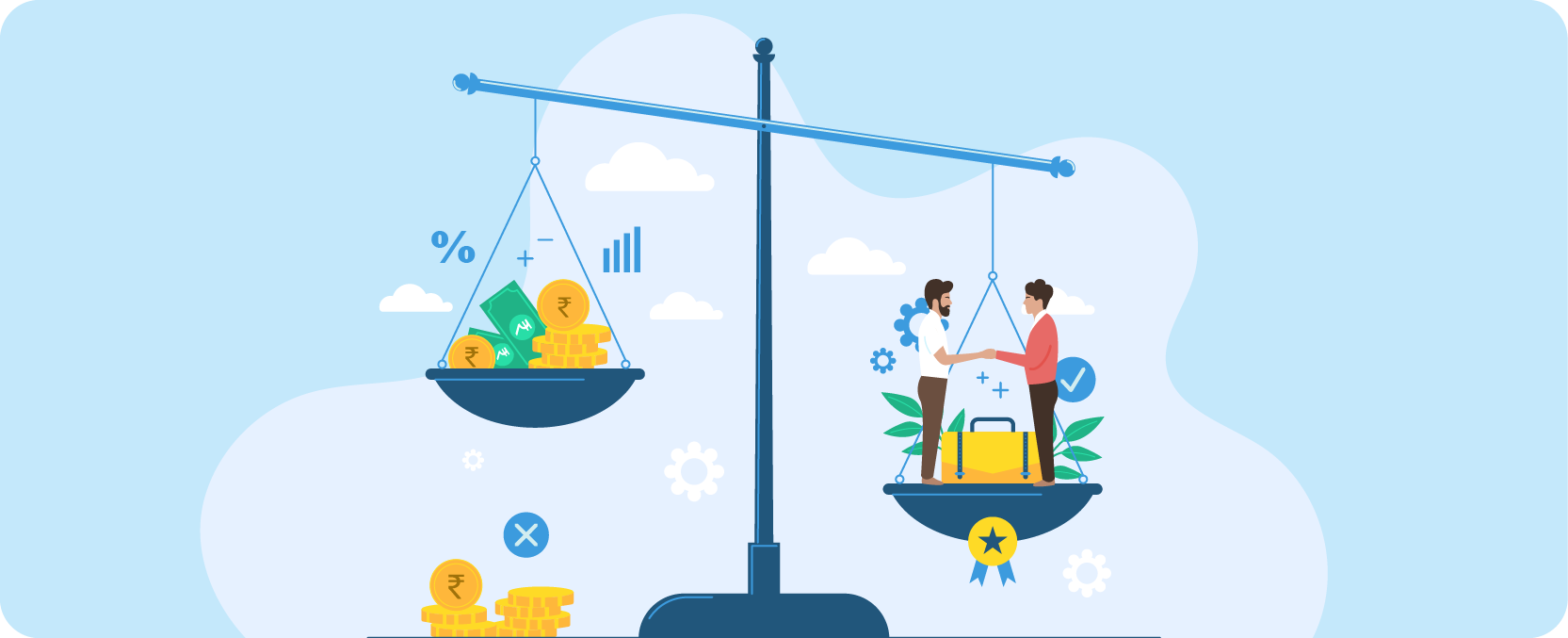- Published on: 14 Oct 2025
- Last updated on: 14 Oct 2025
- Post Views: 678


Personal loans and lines of credit are two common solutions that individuals and businesses can avail themselves of when in need of funds. They are financially flexible and don’t require collateral to avail financing. The key difference between a personal loan vs a line of credit lies in the way they are credited.
With a personal loan, you receive the entire loan amount in your bank account, which you pay in fixed monthly instalments (EMIs) within a set duration. In the line of credit, you can take out money when you need it, pay it back and take out more within your authorised limit. In this blog, we will understand the key difference between a line of credit vs a personal loan and how to choose one.

A personal loan is a type of unsecured loan in which you take a lump sum from a bank, financial institution, or Non-Banking Financial Company (NBFC). You receive the cash all at once, and you repay it through equated monthly instalments (EMIs) for a specified duration.
Suppose you take a personal loan of ₹1 lakh for a year at an interest rate of 14.25% and the lender (Bank or NBFC) imposes a processing fee of 4%. You will receive a lump sum of ₹96,000 into your account and repay the loan by paying an EMI of ₹8,990 every month.
Key Features of a Personal Loan
All these features make a personal loan ideal for big expenses and one-time purchases, including weddings, education, medical emergencies, travelling or vacations.

A line of credit (LOC) is a flexible and revolving credit facility that a lender (banks and NBFCs) offers, and it comes with a set limit. The simple way to understand it is that it acts as a credit card that allows you to draw an amount from the approved limit. You pay interest only on the money that you borrow.
Suppose you have a credit line of ₹3 lakh. You can withdraw ₹50,000 this month, ₹1 lakh next month, or simply nothing if you don’t need any money. You are charged interest only on the ₹50,000 or ₹1 lakh you withdraw, and not on the entire ₹3 lakh limit.
Key Features of a Line of Credit
A line of credit is ideal for managing irregular or recurring expenses, like when you receive irregular payments or have persistent short-term cash requirements.

Here are the key differences between a line of credit vs a personal loan you must know to make the right choice:
| Feature | Personal Loan | Line of Credit |
| Loan Type | Offers a lump sum amount | Offers revolving credit (A facility that allows you to continuously draw, repay and redraw up to a set limit) |
| Disbursement | One-time payment | Withdraw as needed |
| Interest Charged On | Full loan amount | Only on amount used |
| Interest rate | Usually fixed | Often variable |
| Repayment Method | Fixed EMIs | Flexible payments |
| Collateral | Unsecured | Unsecured |
| Credit Limit Reuse | Not possible | Reusable after repayment |
| Ideal for | Planned one-time expenses | Ongoing or uncertain expenses |

A choice between a line of credit vs a personal loan always depends on your financial needs, spending patterns, and repayment capacity.

Both personal loans and lines of credit are great financial tools, but for different reasons. If you need a lump sum for a big expense with periodic payments, a personal loan is ideal for you. A line of credit, on the other hand, offers easy access to funds at all times for varying or irregular expenses.
Whether you are going on a vacation or expanding your business, DMI Finance offers an all-purpose personal loan to help you meet all your financial objectives. We offer lower interest rates starting from just 14.25% and a flexible repayment tenure of up to 48 months. Apply for a personal loan now with DMI Finance and get funds directly to your account.
1. Can I switch my personal loan into a line of credit later?
No, you cannot convert a personal loan into a line of credit because they both have different compositions and terms.
2. Does a line of credit affect my credit score differently from a personal loan?
Yes, a line of credit will affect your credit utilisation ratio, whereas a personal loan will affect your overall debt and payment history. Delaying payments, however, can reduce a credit score in both situations.
3. Which option gives faster access to money: a personal loan or a line of credit?
A personal loan typically provides seamless disbursals, whereas a line of credit provides easy access but is slow to set up in the first place.
4. Can I pay off a personal loan early to save on interest?
Yes, you can save on total interest payable by foreclosing or prepaying a loan, but some lenders may charge a small prepayment or foreclosure fee.
5. Is interest charged daily on a line of credit?
Yes, usually interest on a line of credit is charged daily on borrowed money, which means that interest accrues from the moment funds are withdrawn.
6. Do personal loans and lines of credit have different eligibility checks?
Yes. Personal loans rely more on income stability, while lines of credit focus on credit history and repayment behaviour.
7. Can I use both a personal loan and a line of credit at the same time?
Yes, you can use both a personal loan and a line of credit at the same time, as long as you meet the lender’s credit requirements and can manage the repayments responsibly.
8. Which one has a higher interest rate: a personal loan or a line of credit?
Lines of credit feature variable interest rates that fluctuate based on the repo rate and market conditions, while personal loans have fixed interest rates that never change.
9. Do I need to use my full line of credit limit once approved?
No, you can use any portion of it whenever you need and pay interest only on the amount you actually use.
10. Which is better for emergencies: a personal loan or a line of credit?
A personal loan is usually better for emergencies since it gives you seamless access to funds whenever needed.
| Personal Loan of Different Amounts | ||
| ₹50,000 Personal Loan | ₹1 lakh Personal Loan | ₹2 lakh Personal Loan |
| ₹3 lakh Personal Loan | ₹4 lakh Personal Loan | ₹5 lakh Personal Loan |


